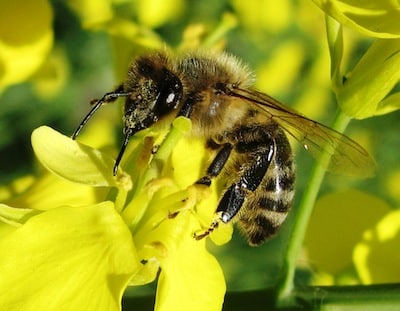Here are best management practices to be friendly with bees and beekeepers:
1. Avoid spraying insecticide on flowering canola. Bees are actively working the crop when it is flowering. Cabbage seedpod weevil (CSPW) is one insect that may require control during flowering. If you need to spray weevils, avoid peak sunshine hours of the day when bees and other beneficials will be most active in the field. Note that some of the common CSPW registered products are synthetic pyrethroids that can lose efficacy at higher temps. This is another reason to spray later in the day. (Keep in mind that bees and other pollinators are attracted to any flowers any time of year, including flowering weeds in crops and in ditches.)
2. Use economic thresholds when making control decisions. We have a good understanding of the ecology of our pest species, and we’re quite confident in the numbers. Remember: Threshold covers cost of application. Not profit! Prophylactic, pre-emptive or preventative — “what if” — applications of insecticides are never a good idea. In addition to losing money from wasted chemical application and potentially harming bees, these unnecessary insecticide applications kill the dozens of species of insects that are beneficial to the canola crop. These include carabid beetles, lady beetles, lacewings, and spiders that are predators that destroy the insects, such as bertha armyworm, which are feeding on and damaging the canola crop. Additionally, reducing the level of pollinators in your field could inadvertently decrease the yield of canola compared to what it would be with higher levels of pollinators. The Canola Encyclopedia has thresholds information in the chapters for all major pests.

3. Use an insecticide registered for the target pest and with lower toxicity. Insecticides that are more target selective or that have lower toxicity are not always the least expensive option, so this will have an impact on economic thresholds. For these products, more pest insects are required to create enough damage to cover the out of pocket cost of this higher cost product. Remember, an ecosystem has a variety of insects. A few pests in the crop is normal, and control should never be enacted unless the damage exceeds the cost of control.
4. Take measures to minimize drift. Constantly monitor wind speed and direction, leave a buffer area (50m) from beehives, and use drift reducing nozzles to keep the product away from non-target areas. Read more about drift prevention tips in the Canola Encyclopedia.
5. Apply products to flowering canola after 9:00 pm until dusk, or into night, when bees aren’t actively foraging. Stop spraying in the morning when temperatures approach 15°C.
6. Maintain dialogue with beekeepers. Knowing where beehives are, when safe times to apply products occur, and who will be there can go a long way to mitigating any potential problems. The beekeeper may be able to move bees during spraying, or cover their hives. Both of these are difficult to time. To make this easier, get the BeeConnected app.
7. Lastly, beekeepers need to report pesticide damage when it happens. This allows beekeepers, the canola industry and regulatory bodies to use accurate data when making decisions.
More….
Canola Council of Canada “Bees & Canola” information
